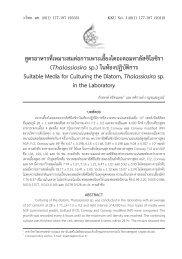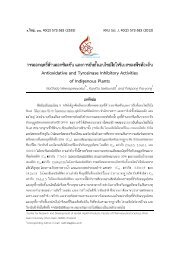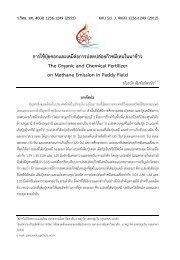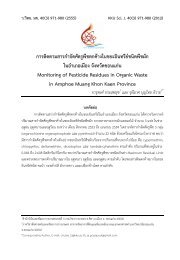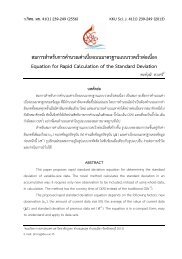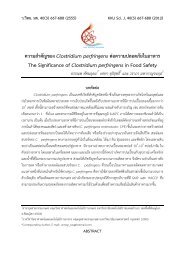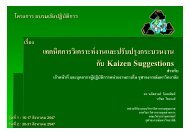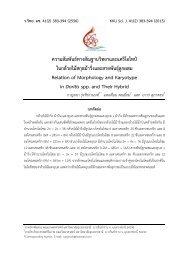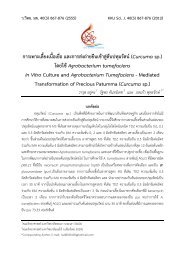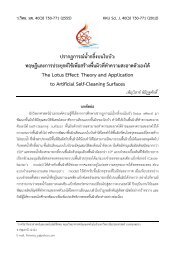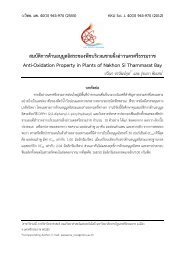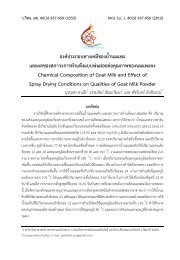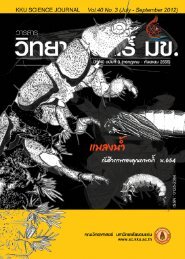Review
Review
Review
You also want an ePaper? Increase the reach of your titles
YUMPU automatically turns print PDFs into web optimized ePapers that Google loves.
106 KKU Science Journal Volume 39 Number 1 Research<br />
Introduction<br />
Dermal ridges on palm, fingertips, and<br />
soles appear in the third to fifth month of fetal<br />
development and the patterns remain unchanged<br />
(Penrose, 1969; Penrose and Ohara, 1973; Okajima,<br />
1975; Nora and Fraser, 1989). Disturbances can be<br />
caused environmentally by diseases such as fetal<br />
rubella, thalidomide poisoning (Penrose and Ohara,<br />
1973) or chromosomal aberration (Schaumann and<br />
Alter, 1976; Rajangam et al., 1995) or maternal<br />
stress during prenatal period (Babler, 1991; Brown<br />
et al., 2000; Rosa et al., 2001). The dermal ridges<br />
on fingertips called fingerprints are arranged in<br />
patterns and classified based on the number of<br />
triradii present (Holt, 1961). Thus, there is no<br />
triradius in a simple arch pattern, one triradius in<br />
loops (ulnar and radial), and two triradii in a whorl.<br />
Since Professor Howard Gardner (1983)<br />
initially identified the original seven different<br />
kinds of human intelligences i.e. linguistic, logicalmathematical,<br />
spatial, musical, bodily-kinesthetic,<br />
interpersonal, and intrapersonal intelligences in Frames<br />
of Mind, then added an eighth intelligence -<br />
naturalistic intelligence (Gardner, 1999). Short<br />
descriptions of those multiple intelligences (MI) are<br />
as follows: linguistic = smart in spoken & written<br />
language; logical-mathematical = smart in numbers<br />
& reason; spatial = smart in patterns of wide space;<br />
musical = smart in rhythm; bodily-kinesthetical =<br />
smart in bodily movement; interpersonal = smart in<br />
understanding other people; intrapersonal = smart in<br />
understanding themselves; naturalistic = smart in<br />
nature & the environment. Human beings are<br />
organisms who possess a basic set of intelligences<br />
and have a unique blend of their intelligences<br />
(Gardner, 1999). Though Gardnerûs theory of MI<br />
has not been readily accepted within academic<br />
psychology, it has however has met with a strong<br />
positive response from many educators and has helped<br />
them to reflect on their practices, and given them a<br />
basis to broaden their focus, and to attend to what<br />
might assist people to live their lives well (Smith,<br />
2008). Factors affecting human intelligences are<br />
biological endowment (including genes, and brain<br />
injuries during development), personal life history,<br />
and cultural background (Armstrong, 1994). The<br />
fingerprint pattern is also inherited from many genes<br />
(Penrose, 1969) and prenatal environments (Babler,<br />
1991; Brown et al., 2000; Rosa et al., 2001).<br />
Therefore, the authors hypothesize that MI and<br />
fingerprint patterns may be related. To assess MI<br />
from a fingerprint pattern would be easy, quick and<br />
useful for parents and teachers to promote the<br />
potentialities of their children. The aim of the pilot<br />
study was to describe the MI scores and analyze<br />
relationships between each MI score and the<br />
fingerprint patterns of school children. This research<br />
protocol had been reviewed and received ethical<br />
approval from the Khon Kaen University Ethics<br />
Committee for Human Research.<br />
Materials and methods<br />
Subjects: A total of 72 high school<br />
children who attended the Olympic academic course<br />
at the Faculty of Science, Khon Kaen University,<br />
northeastern Thailand participated in the study.<br />
Instruments: Four kinds of instruments<br />
were used as follows:<br />
1. Laptop PC.<br />
2. Fingerprint sensor (digitalPersona Inc.,<br />
IT WORKS Co., Ltd., 2005).



